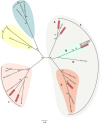The emergence of the Middle East respiratory syndrome coronavirus
- PMID: 24585737
- PMCID: PMC4106996
- DOI: 10.1111/2049-632X.12166
The emergence of the Middle East respiratory syndrome coronavirus
Abstract
On September 20, 2012, a Saudi Arabian physician reported the isolation of a novel coronavirus from a patient with pneumonia on ProMED-mail. Within a few days, the same virus was detected in a Qatari patient receiving intensive care in a London hospital, a situation reminiscent of the role air travel played in the spread of severe acute respiratory syndrome coronavirus (SARS-CoV) in 2002. SARS-CoV originated in China's Guangdong Province and affected more than 8000 patients in 26 countries before it was contained 6 months later. Over a year after the emergence of this novel coronavirus--Middle East respiratory syndrome coronavirus (MERS-CoV)--it has caused 178 laboratory-confirmed cases and 76 deaths. The emergence of a second highly pathogenic coronavirus within a decade highlights the importance of a coordinated global response incorporating reservoir surveillance, high-containment capacity with fundamental and applied research programs, and dependable communication pathways to ensure outbreak containment. Here, we review the current state of knowledge on the epidemiology, ecology, molecular biology, clinical features, and intervention strategies of the novel coronavirus, MERS-CoV.
Keywords: MERS-CoV; coronavirus; epidemiology; intervention strategies; molecular biology.
Published 2014. This article is a US Government work and is in the public domain in the USA.
Figures







References
-
- Albarrak A, Stephens G, Hewson R & Memish Z (2012) Recovery from severe novel coronavirus infection. Saudi Med J 33: 1265–1269. - PubMed
Publication types
MeSH terms
Grants and funding
LinkOut - more resources
Full Text Sources
Other Literature Sources
Medical
Miscellaneous

